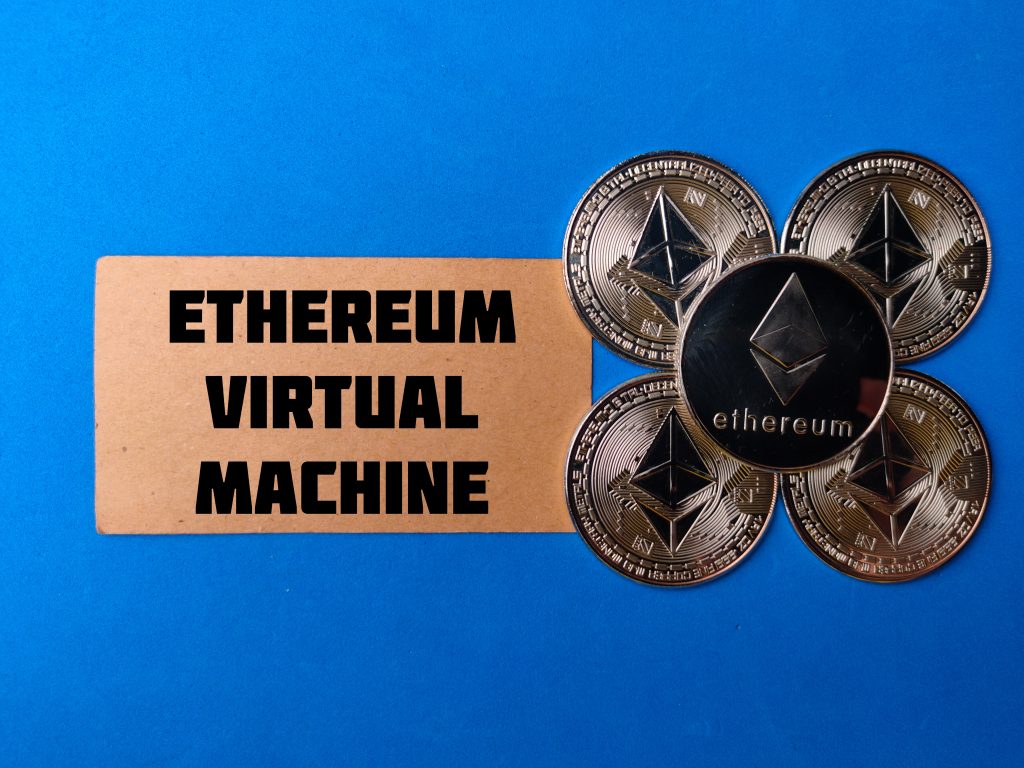Hello, crypto and play-to-earn enthusiasts! Are you ready to venture into the world of blockchain technology? If you’re curious about what powers the blockchain games and NFTs you adore, you’ve come to the right place! In this comprehensive guide, we’ll demystify what is the Ethereum Virtual Machine (EVM), the ingenious engine that enables smart contracts and decentralized applications (dApps) on the Ethereum network.
We’ll make this adventure as engaging and entertaining as possible, so strap in and let’s dive into the fascinating world of the EVM!
Understanding the Ethereum Virtual Machine (EVM)


Think of the EVM as the wizard behind the curtain in the Ethereum ecosystem. It’s a decentralized, Turing-complete virtual machine that allows developers to work their magic, creating smart contracts and decentralized applications on the Ethereum blockchain. But what exactly does that mean?
A Turing-complete system can simulate any other Turing-complete system, making the EVM incredibly versatile. It enables developers to create a wide range of applications, from games and NFT marketplaces to financial services and supply chain management systems.
The EVM serves as the interpreter for smart contract code, translating and executing instructions. This ensures that smart contracts and dApps run securely and efficiently across the Ethereum network, regardless of the specific device or platform you’re using. In other words, the EVM is the glue that holds the Ethereum ecosystem together, ensuring everything runs like a well-oiled machine.
The Inner Workings of the EVM
Now that we’ve introduced the EVM, let’s take a peek under the hood to see what makes this powerful engine purr. The EVM uses a stack-based architecture to process and execute smart contracts and transactions. Picture it like a stack of plates, with each plate representing a piece of data. The EVM adds, removes, or modifies these plates as it executes smart contract code.
One crucial aspect of the EVM is the concept of “gas.” Gas is the fuel that powers the EVM and ensures it runs smoothly. Developers must allocate gas for each operation in a smart contract, and users pay for this gas with Ether, the native cryptocurrency of the Ethereum network. Gas helps manage computational resources and prevents bad actors from clogging the network with spam or infinite loops.
The EVM processes transactions in a series of steps, starting with the compilation of smart contract code into EVM bytecode. This bytecode is then executed by the EVM, with gas costs associated with each operation. Finally, the EVM updates the Ethereum blockchain with the results of the transaction or smart contract execution.
Tracing the History and Evolution of the Ethereum Virtual Machine
Our journey through the EVM’s history begins with its inception in 2014 as part of Ethereum’s development. The brainchild of visionary programmer Vitalik Buterin, Ethereum aimed to create a platform for decentralized applications and smart contracts, and the EVM was the vital component that made this possible.
As Ethereum grew in popularity, the EVM evolved with it. Major updates, such as the Homestead and Metropolis releases, brought improvements to the EVM, enhancing its functionality and paving the way for more sophisticated dApps and smart contracts.
The EVM’s versatility and ability to adapt have been crucial to Ethereum’s success. It has withstood the test of time, enabling Ethereum to maintain its position as the leading smart contract platform in the world of blockchain. As Ethereum continues to grow, the EVM will undoubtedly play a pivotal role in shaping the platform’s future and the decentralized applications that thrive within its ecosystem.
Powering Smart Contracts with the EVM


The EVM is the beating heart of Ethereum’s smart contract ecosystem. It takes the code written by developers and brings it to life, transforming lines of code into decentralized applications that can run autonomously on the Ethereum network.
The process begins with developers writing smart contracts in a high-level programming language like Solidity. The EVM then compiles this code into bytecode that it can understand and execute. This compilation process is crucial for ensuring that smart contracts can run efficiently on the EVM.
Once compiled, the EVM executes the smart contract code in a secure and isolated environment. It ensures that each contract runs independently, without affecting other contracts or the network as a whole. The EVM also maintains the integrity of the Ethereum blockchain by validating and processing transactions related to smart contracts.
Exploring Real-World Use Cases for the EVM and Smart Contracts
The EVM and smart contracts have made a significant impact across various industries, showcasing their versatility and potential. Let’s dive into a few real-world examples of how this technology is changing the game:
- Finance: Decentralized finance (DeFi) is booming, and the EVM has been a key enabler. Projects like MakerDAO, Aave, and Compound leverage the EVM to create decentralized lending and borrowing platforms that offer users greater control over their assets.
- Gaming: The EVM is also leveling up the gaming industry with the rise of play-to-earn and NFT-based games. Games like Axie Infinity and CryptoKitties utilize smart contracts to manage in-game assets and enable players to earn rewards through gameplay.
- Supply Chain Management: The EVM can help streamline supply chain processes and increase transparency. Projects like VeChain use smart contracts to track products throughout their lifecycle, providing real-time data to stakeholders and ensuring product authenticity.
- Identity Management: Self-sovereign identity solutions like uPort rely on the EVM to give users control over their digital identities. Through smart contracts, users can securely store and share their personal data, simplifying online interactions and reducing the risk of identity theft.
These are just a few examples of the countless ways the EVM and smart contracts are being utilized to solve real-world problems. As the technology continues to mature, the possibilities are virtually endless.
Security and Isolation in the Ethereum Virtual Machine


In the world of blockchain, security is paramount. The EVM excels in this department by providing a secure environment for executing smart contracts. It achieves this through isolation, which ensures that each smart contract runs independently, without any interference from other contracts or the wider Ethereum network.
This isolation is crucial for maintaining the integrity of smart contracts and preventing malicious actors from tampering with contract data. By keeping each contract’s execution environment separate, the EVM can guarantee that the code will run as intended and that sensitive data remains protected.
Additionally, the EVM enforces strict resource management by using a mechanism known as “gas.” Gas is a unit of measurement that represents the computational effort required to perform a specific operation within a smart contract. By allocating a gas limit to each transaction, the EVM prevents infinite loops and other resource-draining exploits, ensuring that the network remains stable and secure.
The EVM’s Connection to Ethereum Nodes
The EVM doesn’t exist in a vacuum; it’s tightly integrated with Ethereum nodes, which are responsible for maintaining the network’s consensus and validating transactions. When a user submits a transaction to the Ethereum network, it’s the nodes that process it and determine its validity.
Each Ethereum node runs a copy of the EVM to execute smart contract code and validate transactions. When a transaction is submitted, the nodes verify it against the blockchain’s current state and apply the necessary updates if the transaction is valid. This process is essential for maintaining the network’s integrity and ensuring that only legitimate transactions are recorded on the blockchain.
Nodes are also responsible for propagating transactions and new blocks throughout the Ethereum network. This decentralization is a vital aspect of Ethereum’s security and resilience, as it ensures that no single point of failure can compromise the entire system.
By working hand in hand with Ethereum nodes, the EVM plays a crucial role in facilitating the decentralized, secure, and transparent nature of the Ethereum blockchain.
Getting Started with Solidity and EVM Programming


So, you’re ready to dive into the world of smart contracts and EVM programming? Great! Solidity is the go-to language for creating smart contracts on the Ethereum platform. With its syntax resembling JavaScript, it’s easy to pick up if you’re familiar with other programming languages.
To begin, you’ll want to set up a development environment. You can start by using an online IDE like Remix, which allows you to write, test, and deploy Solidity code within your browser. Alternatively, you can install a local development environment using tools like Truffle or Hardhat.
Once you’re set up, it’s time to start learning Solidity basics. You’ll want to understand concepts like variables, functions, control structures, and events. As you become more comfortable with the language, you can explore more advanced topics like contract inheritance, libraries, and using external contracts.
Exploring EVM Alternatives and Future Developments
The EVM has proven to be a powerful and versatile tool for the Ethereum ecosystem. However, it’s not the only virtual machine out there. Ethereum WebAssembly (eWASM) is an emerging alternative that aims to provide a faster, more efficient, and more flexible execution environment for smart contracts.
eWASM leverages WebAssembly, a binary instruction format designed for secure, sandboxed execution within modern web browsers. By using eWASM, Ethereum could potentially achieve greater performance and compatibility with existing web technologies. However, it’s still in development, and it remains to be seen how it will impact the Ethereum ecosystem in the long run.
Looking ahead, the EVM will undergo significant changes as part of the Ethereum 2.0 upgrade, which is aiming to improve the network’s scalability, security, and sustainability. With Ethereum 2.0, the network transitioned from a proof-of-work consensus mechanism to a proof-of-stake model, which impacts the EVM’s direct role in the ecosystem.
Conclusion
And there you have it—a comprehensive guide to the fascinating world of the Ethereum Virtual Machine! From its inception to its pivotal role in powering smart contracts, the EVM has played a crucial part in shaping the blockchain landscape.
As a decentralized virtual machine, the EVM has enabled developers to create and deploy a wide range of decentralized applications, revolutionizing industries with its versatile and powerful smart contract capabilities. With its robust security features, isolation mechanisms, and integral connection to Ethereum nodes, the EVM remains a cornerstone of the Ethereum ecosystem.
As you embark on your journey into EVM programming, remember to explore the Solidity language and leverage the wealth of resources available to hone your skills. Keep an eye on emerging alternatives like eWASM and the potential impact of Ethereum 2.0, as they may reshape the blockchain space in the years to come.
We hope this guide has piqued your interest and provided you with a solid foundation for understanding the Ethereum Virtual Machine. Embrace the world of decentralized technology, and who knows? You just might be a part of the next blockchain revolution!









